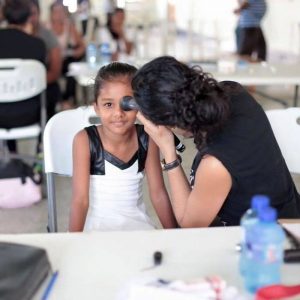Join a powerful, unprecedented alliance for better eye health for all.
Join IAPB-
Choose an alternate language here
I try to imagine how we will reflect on 2020 when it comes to formally write its history. Never have I seen one year bring so much change, and dramatic change at that, to all countries across the world. I have been Co-Chair of the IAPB Gender Equity Work Group since May 2018 and while 2020 has been a difficult year, I will also remember it as a landmark year for gender equity and global eye health. In March, 25 years since the adoption of the Beijing Declaration and Platform for Action, the UN called on everyone to take stock of progress and bridge the gaps that remain through bold, decisive actions. And a few months ago, a World Health Assembly (WHA) resolution was passed, outlining a plan for the next decade of reform in eye care service provision; marking a major milestone for global eye health.
The WHO’s World Report on Vision states that globally there are over 2 billion people living with vision impairment or blindness and for one billion of those people, it is entirely preventable. The WHA resolution calls for political will to become action and make eye care an integral part of Universal Health Coverage (UHC) and to implement ‘integrated people centred eye care’ globally. This is indeed fundamental if we are to move forward. Addressing preventable sight-loss and improving functional ability for people living with blindness will have significant and immediate benefits globally. Good eye health is foundational and without it, functioning in most aspects of life is more difficult, and sometimes, even impossible. The impact of vision loss is exacerbated by social and economic disadvantage and is most profound among the poorest and most marginalised, including people with disabilities, Indigenous populations and women.

Moreover, we know that the COVID-19 pandemic has gendered effects. Men are more likely than women to be seriously ill or die from COVID-19; however, women, especially women of colour, Indigenous women, and low-income women, are particularly susceptible to contracting the disease, as well as feeling the economic instability and curtailed access to services and resources.
As the UN Secretary-General said in April this year: The “limited gains in gender equality and women’s rights made over the decades are in danger of being rolled back due to the COVID-19 pandemic”. We must urge all governments around the world to put women and girls at the centre of recovery efforts. There really is an opportunity for the world to come out of this pandemic more gender-equal and to put an end to gender discrimination in eye health.
That’s why when governments around the world are calling for us to ‘Build, Back Better’, I say – let’s ‘Build Forward Faster’ to ensure the good work already achieved in gender equity and eye health is not allowed to regress because of the pandemic. We mustn’t allow the gaps of today become chasms in the future. #HopeInSight
Photo credit: Hero image: First steps for TT surgery in DRC, by Nick Burn, CBM; Inset: Retinal screening on a 6 y.o. girl, by Pooja Doshi.